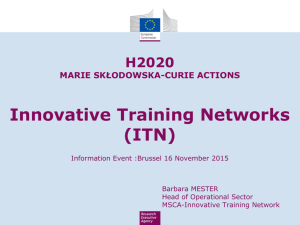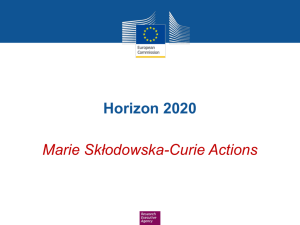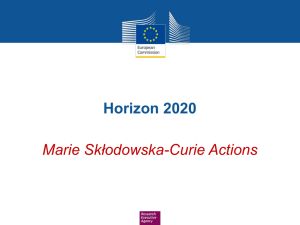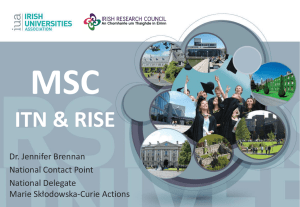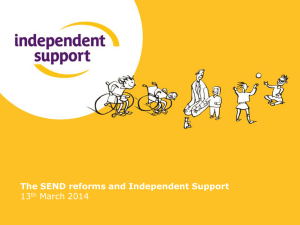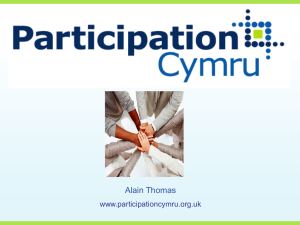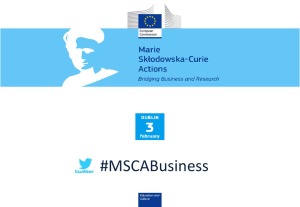MSCA & ITN Call 2014-2015
advertisement
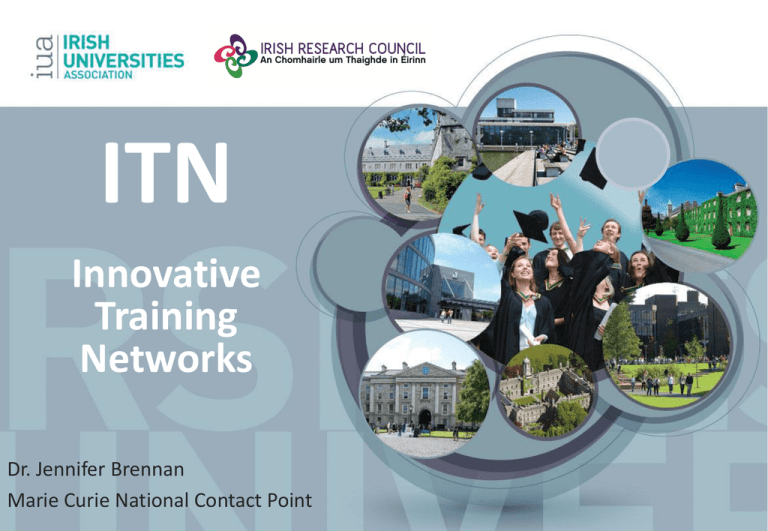
ITN Innovative Training Networks Dr. Jennifer Brennan Marie Curie National Contact Point Irish Universities Association • Who are we? • Representative body for the seven Irish Universities • What do we do? • Support the universities in developing sectoral policies and strategies • What services do we offer to researchers? • EURAXESS Ireland • Irish Marie Curie Office • Available to Universities, IOTs, Research Centres and Companies Irish Marie Curie Office Sponsored by the Irish Research Council (www.research.ie) • Promote the Actions to Irish researchers and research organisations • Support researchers in preparing funding applications • Contribute to policy initiatives relevant to the Actions • • • • • • • www.euraxess.eu ‘One-stop-shop’ centralised support on issues related to mobility For ALL researchers Linked to central EU EURAXESS Site Browse/advertise job opportunities (linked to Nature Jobs) Upload your CV/search CV database Listing of Marie Curie and ERC positions Hosting Agreement: Fast-track immigration procedure for non-EU researchers www.euraxess.ie Marie Curie Actions, an Irish Success Story €571 million • Ireland’s “Take” from FP7 to-date €83 million • Portion of this secured via Marie Curie (2nd Largest FP7 Income-Stream) €25 million • Funding to support research training for postgraduate students 272 5 • Irish Marie Curie Contracts Signed • Among the top 5 performing MS in 2013 Calls Data based on Contracts signed as of July 2013 Which subject areas have been most successful for Ireland? 16% 10% 2% CHE (21) Chemistry 11% 21% ECO (4) Economic Sciences ENG (44) ICT & Engineering 0% ENV (25) Earth & Environment LIF (58) Life Sciences MAT (0) Maths 28% 12% PHY (22) Physics SOC (34) Social Sciences & Humanities Data for Ireland as of July 2013 Horizon 2020 © European Union, 2013 Squo-dovska Marie Skłodowska Curie Actions in Horizon 2020: €6.2 billion budget Training Funds ALL RESEARCH AREAS (no thematic calls or priorities) Implemented via Annual Calls for Proposals Career Marie S-Curie Actions Mobility What’s different to FP7? • 5 Calls instead of 9 • Streamlined finances and shorter time-to-grant • Evaluation Criteria: • Excellence (50%) • Impact (30%) • Implementation (20%) • FP7: Academia-Industry Collaboration. Horizon 2020: Academic – Non-Academic Collaboration Inter-Sectoral Co-operation Academic <-> Non-Academic • Academic: consists of public or private higher education establishments awarding academic degrees, public or private non-profit research organisations whose primary mission is to pursue research, and international European interest organisations • Non-Academic: includes any socio-economic actor not included in the academic sector and fulfilling the requirements of the Horizon 2020 Rules for Participation. e.g. Industry (incl. SMEs), charities, NGOs, government/public bodies, national archives, libraries………… ITN RISE COFUND NIGHT IF • Innovative Training Networks • Research & Innovation Staff Exchange • Co-financing fellowship or doctoral programmes with transnational mobility • European Researchers’ Night • Individual Fellowships Innovative Training Networks Quality of Research Training • Objective: to train a new generation of creative, entrepreneurial and innovative researchers • Propose a Research Training Programme for Early-Stage Researchers (ESRs) • Less than 4 years’ research experience after undergrad Key Aspects • Triple “i” dimension – international, interdisciplinary, intersectoral • Knowledge triangle – research, education, innovation • Employability and Entrepreneurial skills • Exchange of Best Practice amongst participating organisations A Typical ITN • Consortium of organisations from different countries and sectors • Propose a joint research programme • Recruit researchers across the consortium– each researcher has an Individual Research Project • Advanced research skills and complementary skills training • Networking events • Secondments for each researcher to another sector (academic to non-academic, or vice-versa) Two types of participant 1. Beneficiary: recruits researchers and receives a budget 2. Partner: does not recruit researchers, claims costs back from a Beneficiary Two types of sector – Academic, Non-Academic 3 ITN Modes European Training Networks (ETN) European Joint Doctorates (EJD) European Industrial Doctorates (EID) Participation by the non-academic sector is a requirement for all 3 modes ETN – European Training Networks • Country 1 Academia Non-academia Academia Non-academia Academia Academia Non-academia Non-academia Academia Non-academia Country 3 Academia Academia Non-academia Non-academia Academia Non-academia • • • • • Country 2 • Minimum consortium: 3 Beneficiaries in 3 countries (Member States/Associated Countries) No maximum consortium size – typically 6 to 10 Beneficiaries Beneficiaries from any sector No min or max no. of Partner Organisations ESRs funded 3 to 36 months Usually leads to an academic degree award (e.g. MEng, PhD) - not mandatory Max 540 researcher-months (15 PhDs) EJD – European Joint Doctorates • • • • • • • Minimum consortium 3 Academic Beneficiaries in 3 countries (MS/AC) No maximum consortium size – typically 6 to 10 Beneficiaries Beneficiaries from any sector No min or max no. of Partner Organisations ESRs funded 3 to 36 months Must lead to a joint, double or multiple doctoral degree Max 540 researcher-months (15 PhDs) Country 1 Academia Non-academia Academia Academia Academia Non-academia Non-academia Academia Country 3 Academia Academia Non-academia Non-academia Academia Country 2 EID – European Industrial Doctorates • Academia Non-academia • • Non-academia Academia Academia Academia Non-academia Country 1 • ≥ 50% Non-academia Country 2 • • • • Minimum consortium: 2 Beneficiaries in 2 countries (MS/AC) One academic, one non-academic Above this minimum, can add Beneficiaries from any sector No min or max no. of Partner Organisations ESRs funded 3 to 36 months Must lead to a PhD award For 2 Beneficiaries, max 180 researcher-months (5 PhDs) For > 2 Beneficiaries max 540 researcher-months (15 PhDs) Examples from FP7 PROPHET - “Postgraduate Research on Photonics as an Enabling Technology” • Network of 13 Full Partners in 6 Countries from the higher education and private sectors, training 14 research students over 4 years. • Budget M€4.8, coordinated by UCC. ARTISAN – “Adaptive RF front-end for 4G communication systems and beyond” • 2 partners in 2 countries, one academic, one non-academic, training 4 students to doctoral level. Students spend >50% of time at non-academic host. • Budget M€1.2, coordinated by QUB, industry partner is Bell Labs Ireland EXTATIC – “Extreme-ultraviolet and X-ray Training in Advanced Technologies for Interdisciplinary Cooperation” • Erasmus Mundus Joint Doctorate with 8 partners from 5 European countries. • Researchers in the network work towards a joint, double or multiple doctoral degree. • Coordinated by DCU. Can non-European countries participate? “Other Third Countries” – two types 1. Participants listed in Annex A to the Work Programme can participate with no restrictions: • Can be Beneficiaries or Partner Organisations 2. Participants not listed in Annex A to the Work Programme (e.g. USA, Brazil): • • Can be a Partner Organisation Can be a Beneficiary only if: • • They have an S&T Agreement with the EU Their participation is deemed essential by the evaluators (have expertise not available in Europe) Funding Model Categories of eligible costs Marie SkłodowskaCurie action ITN (100%) Costs of researchers (1) Institutional costs (2) Living allowance (a) Mobility allowance (b) Family allowance (c) Top-up allowance (d) 3 110 600 500 -- All values are PER MONTH Research, training and networking costs (a) 1 800 Management and indirect costs (b) 1 200 Proposal Content 1. 2. 3. 4. Summary Excellence Overall page limit of 30 pages No section page limits Impact Implementation Gantt Chart 5. Capacities of the Participating Organisations (tables) 6. Ethical Aspects 7. Letters of Commitment http://ec.europa.eu/research/participants/portal/desktop/en/opportunities/h2020/index.html Evaluation Panels • • • • • • • • Chemistry Physics Mathematics Life Sciences Economic Sciences ICT and Engineering Social Sciences & Humanities Earth & Environmental Sciences Separate Final Ranking Lists for EID and EJD Indicative Call Timetable Activity Publication of Call Date 11-Dec-2013 Deadline Evaluation of Proposals* Evaluation Outcome** 9-Apr-2014 June 2014 September 2014 Signing of Grant Agreements December 2014 * Evaluated by at least 3 international experts ** Distribution across Panels proportional to # of proposals received Evaluation Criteria Criterion Weighting Priority (ex-aequo) Excellence 50% 1 Impact 30% 2 Implementation 20% 3 Overall threshold of 70% No individual thresholds Excellence (50%) Impact (30%) Implementation (20%) Quality, innovative aspects and credibility of the research programme (including inter/multidisciplinary and intersectoral aspects) Enhancing research- and innovation-related human resources, skills, and working conditions to realise the potential of individuals and to provide new career perspectives Overall coherence and effectiveness of the work plan, including appropriateness of the allocation of tasks and resources (including awarding of the doctoral degrees for EID and EJD projects) Quality and innovative aspects of the training programme Contribution to structuring doctoral / early-stage research training at the European level and to strengthening European innovation capacity, including the potential for: Appropriateness of the management structures and procedures, including quality management and risk management (with a mandatory joint governing structure for EID and EJD projects) (including transferable skills, inter/multidisciplinary and intersectoral aspects) a) meaningful contribution of the non-academic sector to the doctoral/research training, as appropriate to the implementation mode and research field b) developing sustainable joint doctoral degree structures (for EJD projects only) Quality of the supervision (including mandatory joint supervision for EID and EJD projects) Quality of the proposed interaction between the participating organisations Effectiveness of the proposed measures for communication and dissemination of results Appropriateness of the infrastructure of the participating organisations Competences, experience and complementarity of the participating organisations and their commitment to the programme The “Charter and Code” and Human Resources Strategy for Researchers (HRS4R) • Charter: researchers’ career management • Code: open and transparent recruitment and appraisal http://ec.europa.eu/euraxess/index.cfm/rights/index • Embedded in Evaluation Criteria for all MSCA (look in the proposal template) • HRS4R: mainstreaming C&C in institutions • Awarded the right to use “HR Logo” • In ROI, UCD, UL, NUIG and UCC are awardees (todate) . Other HEIs are working towards it • In NI, QUB and UU are awardees • If applicable should be included in proposal List of institutions: http://ec.europa.eu/euraxess/index.cfm/rights/strategy4ResearcherOrgs Success Rates • New Programmes, but based on FP7 ITN • 2013 ITN Success Rates • 13% for ITN (precursor to ETN) • 20% for EID • EJD was not in FP7 ITN Calls 2014 and 2015 CALL Opening Date Closing Date H2020-MSCA-ITN-2014 11-Dec-2013 9-Apr-2014 H2020-MSCA-ITN-2015 2-Sep-2014 13-Jan-2015 2014 Call Budget €405 million 2015 Call Budget €370 million • M€349.5 for ETN • M€30 for EJD • M€25.5 for EID • M€317 for ETN • M€28 for EJD • M€25 for EID How the MSC Office can help Information Support • Email Distribution List (mariecurie@iua.ie) • Marie Curie Office Ireland on Linkedin • Dedicated website www.iua.ie/mariecurie • Training Webinars for specific Calls • Advice on whether your concept ‘fits’ the Call • Help to access financial supports from Enterprise Ireland and InterTradeIreland (for ROI/NI collaboration) Thank you! mariecurie@iua.ie www.iua.ie/mariecurie Marie Curie Office Ireland Deadlines 2014 CALL Opening Date Closing Date H2020-MSCA-NIGHT-2014 11-Dec-2013 4-Mar-2014 H2020-MSCA-ITN-2014 11-Dec-2013 9-Apr-2014 H2020-MSCA-RISE-2014 11-Dec-2013 24-Apr-2014 H2020-MSCA-IF-2014 12-Mar-2014 11-Sep-2014 H2020-MSCA-COFUND-2014 10-Apr-2014 2-Oct-2014 Download the Work Programme and Call Documentation at http://ec.europa.eu/research/participants/portal/desktop/en/opportunities/h2020/index.html Work Programme covers Calls in 2014 and 2015 Tips and Tricks! General Comments - 1 • Use a self-explanatory title • A memorable acronym is helpful • Use the proposal template: • It matches the evaluation criteria and makes it easy for the evaluators to find what they are looking for. • It helps you to put the right information in the right place for the evaluators to find it. • Some evaluators use a “checklist” approach to marking – if the information is not in the correct section, they will give you “zero” for that sub-criterion. General Comments - 2 • Use Diagrams, Charts, Tables or Figures where possible • Easy to evaluate • Minimise scientific jargon and write in a clear readable style • Be aware of the overall weighting of each criterion • You need to score well in all sections in order to be funded – don’t spend all your time writing the Excellence section! Abstract (Admin forms) & Summary (Part B) Provided to evaluators to help them choose the proposals they will evaluate • Be concise • Reflect the whole proposal including proposed impact • Identify precise & concrete objectives for the whole proposal, not just the research • Provide enough technical/research information to help an evaluator with knowledge of the field to select it Layout of Proposal Not evaluated but it makes life easier for the evaluators Template Format Language • Use the Correct Template • Use the Template subheadings (provides good structure) • Provide a Table of Contents with page numbers • Use the Full Page Limits • Put the proposal acronym in the Header • Put Page Numbers (format Page X of Y) in the Footer • Use charts, diagrams, tables, text boxes, figures. • Use appropriate font size, line spacing, page margins • Ensure any colour diagrams etc. are understandable when printed in black and white • Use highlighting where appropriate (bold, underline, italics) but don’t overdo it! • Avoid jargon • Explain any abbreviations • Simple clear text • Avoid long sentences • Get rid of repetitions (refer to other parts of proposal if necessary) • Don’t copy text from other documents or websites • Be consistent with language (UK/US English) 2.1 Quality of research programme • Educate the Evaluator • The majority of evaluators will not be expert in the specific subject area of the proposal so…. • Write in a style that is accessible to the non-expert using figures/tables/charts/diagrams to illustrate where appropriate • Research objectives • Make them clear, focused and up front • Relate them to the state-of-the-art and Make sure the ‘state of the art’ is up to date • Include a list of bibliographic references (in footnotes) 2.1 Quality of research programme • Provide a clear, focused description of the research methodology (use diagrams to explain/illustrate your point) • Include a description of any risks associated with the research and contingency plans in case any of those risks occur • Highlight originality and innovative aspects of the proposal • In terms of the research, but also in terms of existing research/doctoral training programmes – why does Europe need an ITN in this research area? • Use a list, table, text box etc. to make them stand out 2.2 Quality of the Training Programme • Spell out the training objectives – remember to explain why this programme is innovative • Need a good balance of individual training and network-wide training events: • Acquisition of advanced research skills, and transferable/complimentary skills must be demonstrated • Use of Personal Career Development Plan is required • Open up some network events to attendees from outside the Network • Explain how any graduate studies programme in the hosts will be incorporated into the training • Secondments: every researcher must get at least one secondment in another sector (academic to non-academic, or vice-versa) • Clearly articulate the role of the non-academic sector in the training (both Beneficiaries and Partner Organisations) 2.1 Quality of the supervision • Clearly demonstrate, with hard evidence, the quality of the research supervisor(s)/institution(s) with regard to the training of researchers • Can be useful to include number of PhDs graduated, numbers of postdocs mentored, number of Marie Curie Actions they participated in • Spell-out the joint supervision arrangements, particularly for EJD and EID • Each researcher should have a non-academic cosupervisor 3.1: Research HR and new career perspectives In all sections, be specific: provide details of how the impact will be achieved. • Explain the impact of the research and training on the fellow’s careers, e.g. • Research skills, transferable skills gained • Exposure to non-academic sector • Look to EU policies on research which refer to training/careers for researchers • • • • E.g. Innovation Union, Agenda for New Skills and Jobs, Youth on the Move Principles for Innovative Doctoral Training and it’s Implementation Report Final Report of the Expert Group on the Research Profession Most docs are available on the EURAXESS Policy Library http://ec.europa.eu/euraxess/index.cfm/services/researchPolicies • Don’t simply cut and paste from EU docs or “pay lip service” by naming them in the document – present an analysis of how the ITN fits in with their objectives 3.2: Structuring research training and EU Innovation Capacity • Spell-out the contribution of the non-academic sector to the research training and the impact it will have • Refer to EU policies again • For EJD – you need to articulate how the programme will contribute to developing sustainable joint doctoral degree structures • E.g. Salzburg II principles - EUA Council for Doctoral Education http://www.eua.be/cde/Home.aspx • Innovation capacity – refer to the impact of the research – link to Innovation Union objectives, research roadmaps, European Standardisation,…… 3.3: Communication and Dissemination What is the Impact of these activities? • Dissemination & Exploitation • Ensure you target multiple audiences, e.g. other researchers, policy makers (can link to European excellence), industry, government science advisors, “think tanks”, legislative bodies….. • Outline plans to exploit any IP arising from the programme • Public Engagement • Do not underestimate its importance – see Guidelines doc at http://ec.europa.eu/research/mariecurieactions/documents/docume ntation/publications/guidelines_en.pdf for details. • Include specifics (what – who – when) in a readable format (e.g. table) • Target different groups (students at all education levels and the general public) – participation in a European Researchers’ Night 4.1: Workplan • Must have a clear work plan • Use the standard tables provided, which use the standard EU format of Work Packages, deliverables and milestones – be clear and concise • Must complete the required Gantt Chart to illustrate timelines • Don’t just have research Work Packages, include, e.g.: • Management • Dissemination, Exploitation and Public Engagement • For EJD and EID, plans for awarding the PhDs 4.2: Management Structure & Procedures • Must have a clear management plan, to explain who will do what and when. Tasks include: • Recruitment (must be open and transparent) • Supervisory board – all Beneficiaries must be represented. Good to have external members • Management of risk in the consortium • Gender aspects – decision making, and recruitment • IPR • …. • Describe which institutional departments will help with managing the programme (Finance, HR etc.) and what their experience is • You can use a PERT chart to illustrate who will be responsible for what templates available at http://www.hyperion.ie/templates.htm 4.3: Infrastructure, Competences and Complementarity • Who is doing what, and do they have the necessary infrastructure to do it? • Infrastructures: technical and other such as office space, access to library and IT facilities etc. • Clearly explain the complementarities between the partners and how these will be exploited (use a diagram or table) • Particularly important to show the commitment of the non-academic sector to the programme • Mutual recognition: how will research carried out at one organisation be recognised by another for PhD award (NB for EID and EJD) 4.3: Infrastructure, Competences and Complementarity - 2 • If you have a Beneficiary from a country who cannot automatically get funding from Horizon 2020, need to explain why they are necessary • Clearly explain role of Partner Organisations (use a figure or table) • Have the organisations endorsed the Charter & Code – if yes, say so! • List at http://ec.europa.eu/euraxess/index.cfm/rights/charterAndCode • Are the organisations towards earning the “HR Excellence in Research” logo? If yes, say so! List at http://ec.europa.eu/euraxess/index.cfm/rights/strategy4ResearcherOrgs But….don’t assume that evaluator knows what this means. Explain it to them. 6: Ethics Issues • All proposals will be checked for ethics issues • Ethics Table is in the Administrative Forms • If you indicate Ethics Issues in the Table: • Clearly describe how Ethical Issues will be managed • How does the proposal meet national legal and ethical requirements of the host country? • Who will oversee the project’s ethical aspects? E.g. institutional ethics committee, Data Protection Officer • Provide sample consent forms etc. • There is no page limit, so provide as much relevant information as possible 7. Letters of Commitment For Partner Organisations • Content is important • Generic letters are not useful • Must contain specifics about role and participation of Partner Organisations and their commitment to do so In EJD, must include Letters from the academic beneficiaries that will award the doctoral degrees (signed by a high-level person) Gender • Gender Quality and Gendered Innovations are mainstreamed throughout Horizon 2020 • Gender experts on every Evaluation Panel • In your proposal, describe • Gender equality in decision making, recruitment, supervisory arrangements • Any gender aspects in relation to the research e.g. cardiovascular research, crash-test dummies
